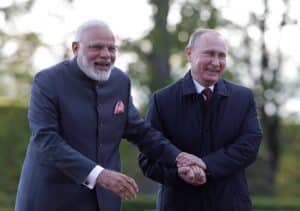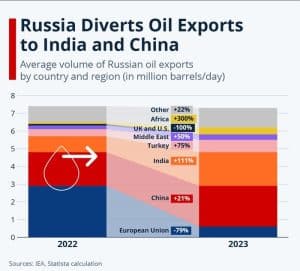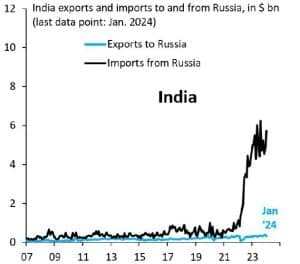PNN – In the past decade and a half, Russian and Indian political circles and experts have formed fixed narratives describing the present and future of bilateral relations between the two countries. While Russian experts remember Moscow-Delhi relations with nostalgia of the days of Soviet-Indian friendship, Indian experts look at this situation with a more pragmatic view, in their view, Russia is a balancing force between India’s relations with the United States and China.
The last time Indian Prime Minister Narendra Modi visited the country to meet Russian President Vladimir Putin was almost five years ago, in September 2019. The year after that, the outbreak of Covid-19 and the Russian leader postponed Modi’s visit until December 2021. Months later, the Ukraine crisis erupted, and since then the annual bilateral meetings between the two presidents have been informally suspended. Finally, Modi went to Russia again and it was a very different visit than his previous ones, because in the last two years, India-Russia relations have undergone a massive transformation that would have been hard to imagine even five years ago.
How do India and Russia look at me?
In the past decade and a half, Russian and Indian political circles and experts have formed fixed narratives describing the present and future of bilateral relations between the two countries. While Russian experts remember Moscow-Delhi relations with nostalgia of the days of friendship between the Soviet Union and India and also lament the stagnation of trade between the two countries, on the other hand, Indian experts look at this situation with a more pragmatic view.
In their worldview, Russia is a balancing force in India’s foreign policy towards the country’s strong orientation towards New Delhi’s most important non-regional partner, the United States. Also, from the point of view of Indian experts, relations with Russia should not be affected by unilateral decisions of the West at this time, because the excessive weakening of relations with Moscow can push the Kremlin towards an alliance with Beijing, which can be a great risk for Delhi in the long run.

On the other hand, in their view, Russia is some country rich in resources that can increase China’s economic and military power in the medium term, and this is in direct conflict with India’s foreign policy interests. As a result, the development of political dialogue with Russia and the formation of a new multipolar world in which Moscow, as one of the world’s power centers, is a reliable partner for New Delhi, will fully meet India’s strategic goals in the international system and in strategic competition with China.
Ukraine war and shock to India’s foreign policy
The start of Russia’s special military operations in Ukraine is a big shock for Indian policymakers. At that time, the Indian leadership had generally begun to draw up and implement a plan for a major restructuring of the national economy that would ensure sustainable growth of more than 5 percent per year and India’s gradual emergence as the world’s third largest economy in terms of GDP. It was believed that the implementation of this policy, in turn, helped to significantly reduce social tensions.
This required a relatively stable situation in India’s foreign policy on the one hand and the continuation of the dispute between the United States and China on the other hand, which led to the withdrawal of Western capital from China and the development of alternative production chains in other parts of the world. India was expected to use the dynamics of the international system and be able to attract western capital that brought modern technologies with it and facilitate the growth of its economy.
In this scenario, the United States, Japan, Taiwan, Singapore, Israel and European countries played the role of suppliers of capital and technology and the rich Persian Gulf countries played the role of investors for the Indian economy, while China played the role of an enemy and Russia played the role of a balance.
This whole plan of the Indian elite, after the start of the operation in Ukraine, was destroyed overnight. Russia was no longer a balancing force and relations between India’s western partners and Russia quickly deteriorated. Moscow moved economically towards Beijing, while India’s relations with China remained as strained as in previous decades.
In this situation, India was faced with a choice: The Modi government had to decide whether to destroy the entire support system of its strategic independence that it had been building for decades, submit to Western pressure and join the anti-Russian camp, or Adhere to the previous one. Of course, hoping that the Ukrainian crisis will end very quickly and predictably in the future, so that the situation may improve more or less. Showing considerable political flexibility, the Indian leadership chose the second option.
Choosing this strategy was easier for India than European countries: For Indian politicians, the Ukraine crisis was a relatively unimportant conflict somewhere in the western end of Eurasia. Moreover, Kiev has been actively developing cooperation in various fields, especially in the military sphere, with Islamabad in recent years.
Of course, many people in India sympathized with the Ukrainians in this conflict, especially among the middle class who get information about world events from the Western media, but the crisis in Ukraine does not have a serious impact on India’s domestic policy agenda.
Of course, there were only two notable incidents: the evacuation of Indian students from Ukraine at the very beginning of the conflict and the news of Indians signing up as contract soldiers in the Russian army. The ruling party and Modi personally turned the first part to their advantage by organizing the student repatriation operation. But in the second case, the Indian media is still covering the news of this story, but after the end of the presidential election, it is time to discuss the opportunities and challenges in Moscow-New Delhi relations.
Moscow-New Delhi economic ties are the biggest winner of the Ukraine war
Before the Russian military operation in Ukraine, Russian-Indian trade was practically stagnant, and many efforts were made to cross the $12 billion mark, although a small part of this growth was due to the fluctuations of the dollar price in the world markets. Traditionally, the economic cooperation between Russia and India is based on three pillars: Military-technological cooperation, nuclear energy and space, India’s exports of food and light industrial products to Russia were slowly increasing, and Indian pharmaceuticals were steadily gaining a foothold in the Russian market.

But after the start of operations in Ukraine, Russia’s economic relations with the West began to crumble, and the country’s economy immediately focused on new markets, including India, to compensate for its disharmony. The trade was growing at an extraordinary rate, jumping from $12 billion to $65 billion in two years, with crude oil accounting for a large portion of this growth.

At first, Western countries tried to cut off this economic flow with the pressure of sanctions, but the large size of the Russian economy showed an extraordinary ability to escape sanctions. They used shell companies in third countries or shadow fleets along with other tricks. The large volume and high profitability of Indian trade helped the Russians to create routes to circumvent the sanctions. Ultimately, this strategy paid off, as Western political and economic elites, realizing that their economies could collapse without Russian energy, generally accepted the new realities of the international system.

One of the serious ways to bypass the sanctions for Russia was to use small Indian business companies. Although large holdings played a significant role as the driving force of increasing trade between the two countries, it was the smaller Indian companies that were able to bypass the sanctions and import products with advanced western technology or advanced domestic products of India to help the Russian economy. Apart from providing Russia’s basic needs in the technology sector, this strategically allows the Russian economy to avoid mere technological dependence on China and not to define itself under China.
According to statistics and documents, the trade between India and Russia continues to grow, but more importantly, the construction of production chains with the participation of Russian and Indian companies is underway. This is necessary both for Russian companies, which can eliminate at least part of their production under sanctions, and for Indian companies.

Golden window of India
Looking at the conditions of the last two years of the war in Ukraine, it should be noted that India is benefiting significantly from the conflict between Russia and Ukraine. Never before had this volume of oil been injected into the Indian economy at such a low price. In addition, Russian entrepreneurs seeking to circumvent Western sanctions have begun to identify the Indian market and have injected knowledge, money and technology into these markets. However, there are downsides to this business, such as: entering the Russian market now can be risky, trading in the Russian market is difficult in the current situation, and necessarily constant political maneuvering has not always been fruitful.
Moreover, Indians don’t even know what direction the future conflicts will take. Perhaps one of the most important goals of Modi’s visit to Russia after five years is to understand Putin’s thoughts on the future of conflicts.
Some of these experts expected that the Ukrainian side would be able to make significant achievements in the field during their counterattack in 2023. But the result was something close to zero. The form the conflict has now taken has presented an incomprehensible picture to the Indian authorities.
Behind the secret war between China and the West, India has a great chance to play the role of an arbiter or a great moral power, to play the role of a mediator and conciliator. From this point of view, the visit of Indian Deputy Foreign Minister Pawan Kapoor to Geneva and Narendra Modi’s visit to Moscow may be links in this chain.
In the past two years, in the background of the growth of political and commercial relations between Moscow and New Delhi, the two countries tried to avoid provoking the western countries about this relationship as much as possible and emphasize its practical results.
But now Western capitals will surely welcome Modi with a warmer embrace. The conflict in Ukraine is erosive, Kiev is clearly not going to win on the battlefield, and not only Russia, but also the West is suffering from sanctions imposed against the country.
Conclusion
Modi’s visit to Moscow – his second foreign trip since his re-election in June – shows the importance Delhi places on relations with the Kremlin. As a rising global power, New Delhi is keen to prioritize its strategic interests while balancing relations with the West, Russia and China.
While New Delhi has called for “dialogue and diplomacy” to end the Ukraine war, at the recent Ukraine peace conference in Switzerland, India’s representative did not sign a joint statement calling for respect for Ukraine’s territorial integrity.
Russia is also keen to further expand the International North-South Transport Corridor (INSTC), a road, sea and rail project connecting Russia to India via Iran. Last month, Russia sent the first part of its coal shipment to India through the North-South Corridor.
The project has been in the works for more than two decades, and given the constraints Russia faces from Western sanctions, INSTC is now a key business priority for the Kremlin.
Completing another project that has gained new urgency for the two countries is the Chennai-Vladivostok maritime corridor. First proposed in 2019, the 10,300 km (5,600 nautical mile) sea route from Russia’s easternmost region could help secure the flow of Russian energy and other raw materials to India.
The proposed corridor is expected to reduce transit time from 40 to 24 days compared to the existing route through the Suez Canal.
Considering all the political and economic issues between the two countries, it seems that the West will hardly be able to place New Delhi as one of the most dynamic economies in the world in the puzzle of Russian sanctions in order to influence Moscow’s war economy. India desperately needs cheap Russian energy carriers such as oil and coal to move the locomotive of its economy. On the other hand, Russia can balance China’s policies in the Asia-Pacific region.

